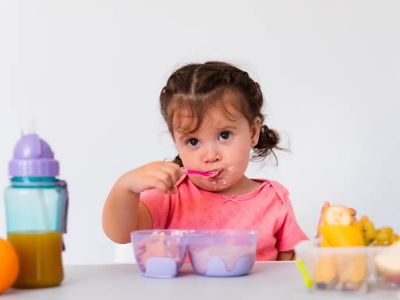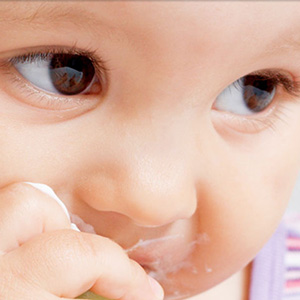Congratulations your baby is nearly one! So along with finalising the party invite list and making the cake, you might be wondering about how to transition from formula to cows milk.
How to switch from formula to regular milk
The first change to make when your baby turns one is to switch from the formula if you’re using that to regular milk. If you’re breastfeeding or feeding your baby expressed milk then keep doing that!
It’s OK to make a straight swap from formula to whole cows milk
Many parents take this approach. But others like a more gradual introduction to regular milk and that’s fine too. You can mix cows milk with the formula (or breastmilk) little by little until your baby gets used to the taste of it. The goal is to add more cows milk and less formula (or breastmilk) until you’ve completed swapped one for the other. And you can ease the transition by heating it a little if this is what they’re used to when drinking formula.
If your baby tolerates regular formula they’ll tolerate cows milk
If your baby tolerates regular formula or has been eating food made with cows milk, cheese and yoghurt then they should have no problems handling regular milk as a drink. Infant formula is made from modified cows milk meaning the proteins are similar as are those in cheese and yoghurt.
Switch from bottles to cups
After you’ve swapped over to regular milk, the next step is to swap out bottles for cups or beakers.
Why bottles need to go!

Prolonged use of bottles can lead to a variety of problems – including tooth decay, nutritional issues and speech delay.
- Tooth decay: Milk naptime or night-time are particularly harmful as the natural saliva in the mouth that protects the teeth from acid is reduced.
- Nutritional problems: Many parents worry that when they take the bottle away, their child’s milk intake reduces. But too much milk will fill your child’s tummy, making them less hungry for solids and may also affect iron absorption. It’s much easier to drink too much milk from a bottle than from a cup. You’ll see how easy it is for your baby to get enough milk products during the day without bottles.
- Speech delay: Unlike bottle feeding, the skills attached to drinking from an open or straw cup strengthen the muscles in the mouth used for speech.
You have two options for getting rid of bottles
The choice is yours!
The chances are that at age one your baby is drinking three bottles of milk a day. Babies commonly drink a bottle when they wake up, mid-morning or mid-afternoon and one before bed.
Option 1: Cold turkey!
This means swapping all your baby’s bottles for cups at once. So you will offer milk from a cup with breakfast, a cup of milk with a snack mid-morning and mid-afternoon and a cup of milk before going to bed. The reason you’re offering milk more often now is that it’s unlikely that your baby will drink the same amount of milk from a cup as they will from a bottle.
LEARN MORE: You’ll find a typical day here for a toddler.
Option 2: Softly, softly approach
Phase each bottle out one by one. The first and easiest bottle to drop is the day-time bottle, and it’s easy to replace this with a snack and milk. As you try to stop the first bottle, keep offering the other two bottles for about a week. That way, if your baby looks for the bottle, you can assure them that one is coming later.
You can read more about healthy snacks here
The next bottle to go is usually the early morning one. The easiest option here is to offer milk with breakfast instead. You can always bring breakfast forward if you need to.
And the last and often most challenging bottle to eliminate is the bedtime bottle. However, it’s OK to offer milk from a cup before bed. Try to do before brushing your baby’s teeth. The bedtime bottle tends to be a part of the bedtime routine and is the one that most provides comfort to babies. Instead of the bottle, try offering a cup of milk and continue with the rest of your night-time routine, like a bath, bedtime story and teeth brushing. It might help to give your child a comforting object to cuddle with, like a blanket or a favourite toy.
Here are some other things to keep in mind when switching bottles for cups
When your baby does use the cup, offer plenty of praise and positive reinforcement. If you keep getting asked for a bottle, respond calmly and positively, consider your baby’s needs for comfort and reassurance, try to distract and offer alternatives, e.g. playtime or a cuddle. Get rid of the bottles or put them out of sight and ensure that other people looking after your baby being consistent too. No point you going to the effort to drop the bottles if the childminder is still offering them at her house!
Choosing the right cup
Here are some other things you may be wondering about when you make the switch from formula to cows milk
What about formula or ‘growing up milk’?
Supermarkets might stock ten brands of growing up milk. But that doesn’t mean your baby needs it. It’s smart marketing designed to part you from your money.
Nutritionally, there’s no need for formula after 12 months unless you’ve been advised otherwise by a health professional like your dietitian. Your baby can and should get the nutrition they need from their meals and regular milk.
My child is fussy should I use growing up milk?
Toddler milk and growing-up milk contain more sugar than cows milk and less of some essential nutrients such as riboflavin, calcium and iodine. Manufacturers add some nutrients to toddler milk – such as iron, vitamin D and omega-3 fatty acids – but they do not replace all the nutrients that may have been destroyed in processing. Experts have agreed that young children do not need growing up milk to obtain particular nutrients.
Does cows milk cause constipation?
You might notice a change in your baby’s poo when you change from formula to cows milk as your baby’s digestive system adapts.
LEARN MORE: Worried about constipation and weaning? 6 easy ways to keep things moving!
What about baby’s who are drinking goats milk formula?
The proteins in goats milk and cows milk are very similar, and so if your baby tolerates goats milk, there is a good chance that they’ll be fine drinking regular milk. However, if you’d prefer for them to drink goats milk then it’s fine to switch to regular goats milk once they turn one.
What about vitamin D?
When your baby switches from formula to whole milk you will need to supplement with vitamin D over the winter. In Ireland we recommend giving children aged 1-4 years 5 micrograms of vitamin D from Halloween to St. Patrick’s Day.
READ MORE: How to give your baby vitamin D
My baby is drinking 7oz bottles of formula now, and I can’t see them drinking 7oz of milk from a cup!
You’re right, and it’s doubtful that your baby will drink the same volume of milk at one sitting from a cup as from a bottle. This is one of the reasons why it’s good to phase out bottles at one. Because while milk is still an essential part of your child’s diet it’s not as important as it used to be!

Ages 1 to 4: 3 servings a day
One serving is:
- 200ml plain milk
- One-pot (125g) plain yoghurt
- Two small pots (47g) plain or natural fromage frais
- Two adult thumbs of cheese
- homemade custard or rice pudding made with 200ml of milk
- 2 x 100ml unsweetened soya milk fortified with calcium
One serving can combine two foods or drinks. For example, one serving could be 100ml of milk with one small pot (47g) plain or natural fromage frais. Or 100ml milk with one adult thumb of cheese.
Why is whole cows milk recommended?
Whole milk is preferred (breastmilk or whole cows milk) until age two. After that, you can continue to breastfeed, stick with whole milk or switch to low-fat dairy. Skimmed milk isn’t suitable for children under five years old.
What if my baby is allergic to milk or I don’t want to offer cows milk for personal reasons?
If your baby has a cows milk protein allergy, ask your dietitian for advice. Many babies will stay on their special formula through the second year. However, if you’re raising your baby in a vegan lifestyle, fortified soya milk or fortified pea milk are the best plant-based options. As you can see here, plant-based milk vary a lot in their nutritional value.
Would you like to learn more about WHAT and HOW to feed your toddler? Then check out my Feeding Your Toddler Online Course.












0 Comments